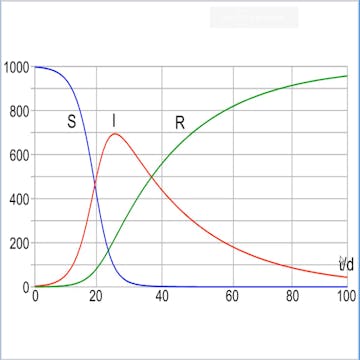
In this 1-hour long project-based course, you will learn basic principles of agent-based SIR models and how one can be implemented in Python. Together, we will explore basic Python implementations of SIR differential equations and agent-based modeling from scratch. This will be accomplished using Matplotlib and Numpy.
I encourage learners to experiment. What other variables can be added? Can our variables be represented better? What limitations do we come across? The learner is highly encouraged to experiment beyond the scope of the course.
After you finish the course, you will have the basic knowledge of building a mathematical...
Read more
Good to know
Save this course
Reviews summary
Pandemic modeling in python
Activities
Connect with Experts in Agent-Based Modeling
Show steps
Enhance your learning by connecting with experienced professionals who can provide guidance and support.
Browse courses on
Python
Show steps
-
Attend virtual conferences or workshops to meet experts.
-
Reach out to researchers or practitioners in your field through LinkedIn or email.
Run Simulations with Small Changes
Show steps
Practice and deepen your understanding of agent-based SIR models by running simulations with small changes to variables.
Browse courses on
Simulation
Show steps
-
Modify the transmission or recovery rate in the model.
-
Run the simulation and observe the changes in the output.
-
Repeat steps 1-2 with different parameter changes.
Organize and Review Course Notes and Materials
Show steps
Solidify your understanding by organizing and reviewing the materials covered in the course.
Show steps
-
Compile your notes, assignments, and quizzes into a coherent document.
-
Review the materials regularly to reinforce concepts and identify areas for improvement.
Three other activities
Expand to see all activities and additional details
Show all six activities
Write a Blog Post Summarizing the Course
Show steps
Reinforce your understanding of the concepts covered in the course by writing a blog post that summarizes the key takeaways.
Browse courses on
Python
Show steps
-
Summarize the main principles of agent-based SIR models.
-
Provide examples of how these models can be applied in various domains.
-
Share your insights on the limitations and potential improvements of these models.
Explore Online Tutorials on Advanced Agent-Based Modeling Techniques
Show steps
Enhance your skills by seeking out and completing tutorials on advanced topics related to agent-based modeling.
Browse courses on
Python
Show steps
-
Identify online platforms or repositories that offer tutorials on agent-based modeling.
-
Select tutorials that align with your learning goals and skill level.
-
Complete the tutorials and apply the concepts to your own projects.
Develop a Custom SIR Model for a Specific Scenario
Show steps
Apply your knowledge of agent-based SIR models to a real-world scenario by developing a custom model for a specific disease or context.
Browse courses on
Python
Show steps
-
Define the parameters and assumptions of your custom model.
-
Implement the model in Python using Matplotlib and Numpy.
-
Run simulations and analyze the results to draw meaningful conclusions.
Connect with Experts in Agent-Based Modeling
Show steps
Enhance your learning by connecting with experienced professionals who can provide guidance and support.
Browse courses on
Python
Show steps
- Attend virtual conferences or workshops to meet experts.
- Reach out to researchers or practitioners in your field through LinkedIn or email.
Run Simulations with Small Changes
Show steps
Practice and deepen your understanding of agent-based SIR models by running simulations with small changes to variables.
Browse courses on
Simulation
Show steps
- Modify the transmission or recovery rate in the model.
- Run the simulation and observe the changes in the output.
- Repeat steps 1-2 with different parameter changes.
Organize and Review Course Notes and Materials
Show steps
Solidify your understanding by organizing and reviewing the materials covered in the course.
Show steps
- Compile your notes, assignments, and quizzes into a coherent document.
- Review the materials regularly to reinforce concepts and identify areas for improvement.
Write a Blog Post Summarizing the Course
Show steps
Reinforce your understanding of the concepts covered in the course by writing a blog post that summarizes the key takeaways.
Browse courses on
Python
Show steps
- Summarize the main principles of agent-based SIR models.
- Provide examples of how these models can be applied in various domains.
- Share your insights on the limitations and potential improvements of these models.
Explore Online Tutorials on Advanced Agent-Based Modeling Techniques
Show steps
Enhance your skills by seeking out and completing tutorials on advanced topics related to agent-based modeling.
Browse courses on
Python
Show steps
- Identify online platforms or repositories that offer tutorials on agent-based modeling.
- Select tutorials that align with your learning goals and skill level.
- Complete the tutorials and apply the concepts to your own projects.
Develop a Custom SIR Model for a Specific Scenario
Show steps
Apply your knowledge of agent-based SIR models to a real-world scenario by developing a custom model for a specific disease or context.
Browse courses on
Python
Show steps
- Define the parameters and assumptions of your custom model.
- Implement the model in Python using Matplotlib and Numpy.
- Run simulations and analyze the results to draw meaningful conclusions.
Career center
Disease Modeler
Epidemiologist
Mathematician
Statistician
Biostatistician
Public Health Analyst
Physicist
Healthcare Data Analyst
Quantitative Analyst
Computer Scientist
Operations Research Analyst
Actuary
Data Scientist
Software Engineer
Reading list
Share
Similar courses
OpenCourser helps millions of learners each year. People visit us to learn workspace skills, ace their exams, and nurture their curiosity.
Our extensive catalog contains over 50,000 courses and twice as many books. Browse by search, by topic, or even by career interests. We'll match you to the right resources quickly.
Find this site helpful? Tell a friend about us.
We're supported by our community of learners. When you purchase or subscribe to courses and programs or purchase books, we may earn a commission from our partners.
Your purchases help us maintain our catalog and keep our servers humming without ads.
Thank you for supporting OpenCourser.



